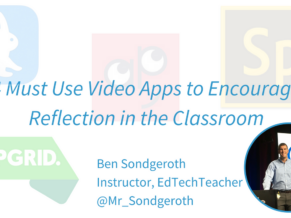Want to learn what Ben is up to? Follow him on Twitter @Mr_Sondgeroth
While completing my undergraduate degree in history education, I recall having to submit a written reflection after completing every lesson. I also remember being somewhat annoyed at the process and questioned the purpose of reflecting back on my work after already completing a lengthy lesson plan. Fast forward to my time as a classroom teacher and I came to realize that reflection served an invaluable purpose. Formal opportunities for reflection allow us to pause, look back, identify and analyze the points we should improve upon as we move forward. Great teachers regularly engage in reflection and if their first lesson of the day does not go well, they reflect on what needs improvement and adjust to ensure the same mistakes do not happen again.
As teachers, we use the power of reflection to improve student learning and it is important to promote reflection with our students. In their book Learning and Leading with Habits of Mind, Arthur Costa and Bena Kallick (2008) point out that: “Teachers who promote reflective classrooms ensure that students are fully engaged in the process of making meaning. They organize instruction so that students are the producers, not just the consumers, of knowledge.”
For students using iPads, three amazing and free apps -- Recap, Adobe Spark, and Shadow Puppet Edu -- can support the process of capturing a reflection in more than just writing at the end of a long assignment. In using these apps, teachers can help students understand that their reflections are more than simply writing an essay at the end of a project.
1) Recap
Recap is a web-based video reflection tool that allows students to capture their thinking using their iPad. Teachers can create assignments called “Recaps” and students can record video responses for up to 5 minutes each.
Teachers first create an account at letsrecap.com on their computers, then they invite students to join a class. Teachers can pose reflection questions to the students within Recap by simply typing out a question or by recording a video of themselves asking a question. Using the Recap iPad app, students respond to the teacher’s question by recording a short video of themselves. Ultimately, teachers review the student video responses to check for understanding.
Recap can provide teachers with a new perspective on how students may have engaged with curriculum content. For instance, a language teacher might want students to record a reflection on a short story they read in class to evaluate their understanding of a story character or a writing technique. An art teacher might want students to hold a picture they’ve painted and explain their thought process as they created that object. A science teacher might want students to video themselves with a piece of lab equipment reflecting on why their use of the equipment may or may not have resulted in the outcome they expected. In short, there are all types of subject content and activities that be incorporated into Recap video reflection.
2) Flipgrid
Flipgrid is an amazing tool for teachers to create safe and secure video discussions for their classrooms. The free version allows teachers to assign students discussion prompts and have students contribute video responses. With Flipgrid, student-created responses are posted for all other students to see and react to. Flipgrid also allows teachers to share student posts with a broader audience. The teacher can control the size of an audience, from one as small as one class, to one as wide as the world.
In the reflection process, teachers can post a reflective prompt for students to respond to. Students can use the Flipgrid app to record their thinking and post the video to the class grid. Once their video is posted, students can watch and listen to other student videos.
For example:
- Math teachers may use Flipgrid as a way for students to explain how they worked through a complex problem or equation.
- Social studies teachers may use Flipgrid for students to post a video describing what they currently know about a topic. For instance, students might post a new video reflecting on how their learning evolved during a unit.
- Literature teachers and history teachers could use the same grid to have students collaborate on a topic covered in both classes. For example, students could read The Grapes of Wrath in their literature class, while concurrently studying the Great Depression in their history class. Students can use Flipgrid to post historical reflections on how the time period in history is portrayed by the author of the novel.
3) Adobe Spark Video
Adobe Spark Video enables students to create videos on their iPads first by importing images and videos into a timeline and then recording their voice over the content. As a reflection tool, students could embed videos and images that directly relate to a unit explored in class. When each artifact of learning displays, students can reflect on how that artifact impacted their learning. Students can share their finished Spark videos via a link to their teacher, save the video file to their photos app, or publish it on the web. Consider the following examples of how this may be used.
- Students in a social studies class can research primary source text, images, or videos related to a recently completed unit. Upon inserting those sources into their Adobe Spark Video projects, students can then verbally reflect on each piece of content in their video.
- In a language arts class, students can bring in images that make up components of a novel or literature work they are reading. As they progress through the text, students reflect on what they just read.
- In a science classroom, students can take images throughout a lab, documenting the steps in the process. When finished, students can insert those images/videos into their Spark project and reflect back on each step.
4) Shadow Puppet Edu
Shadow Puppet Edu enables students to create a video reflection consisting of text, images, narration, animation, and music. Shadow Puppet Edu is a great option for all students, as it requires no student login and can be very user-friendly for even our youngest learners. When using the app, students can insert images and videos into their project and then record their voice over their content. Students are also able to use the wand tool to write on their content and insert text to further expand on their ideas. Shadow Puppet Edu also offers an expansive image library, including images from the Library of Congress, NASA, the MET, and much more! (Teachers should test this feature while at their school first, as some school filters block these image databases.)
In using Shadow Puppet Edu with reflection, students can tell a story about their learning by inserting images and videos while using the tools available in the app to enhance their reflection. Creations inside of Shadow Puppet are automatically saved to the camera roll and can be shared via a link and posted to SeeSaw!
For instance...
Check out the “Ideas” section in Shadow Puppet EDU for CCSS-aligned activities organized by Family Heritage Map, Historical Landmark, City Math, Symbolism in Art, Weather Report, and Guess Who? There are many ways students can use Shadow Puppet EDU to show and reflect on what they have learned about a topic.
Where can you find resources to guide students?
Giving the students the tools to foster reflection is a great first step in the process, but simply giving them the tools and not guiding them through the reflection process may stop the reflection process. To keep students asking the right questions while reflecting, consider using Visible Thinking Routines from Harvard’s Project Zero. These routines are designed to help students process content in a manner that is active and engaging.
Consider the following routines to help students in their reflection:
I Used to Think …., But Now I Think
Reflection is a powerful learning tool to use with students. Costa and Kallick encourage teachers to remember the three reasons that reflection is important: to help students become aware of, to help students take more responsibility, and to help students see growth in their learning (Costa & Kallick, 2008). By bringing creative technology tools into the reflection process, teachers can foster a continual learning environment in which students can look back, to learn how to move forward.
References
Costa, A. L., & Kallick, B. (2008). Learning and leading with habits of mind: 16 essential characteristics for success. Alexandria, VA: Association for Supervision and Curriculum Development.


